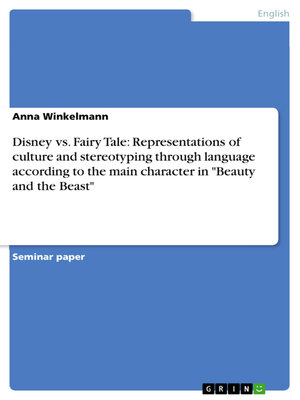Disney vs. Fairy Tale
ebook ∣ Representations of culture and stereotyping through language according to the main character in "Beauty and the Beast"
By Anna Winkelmann

Sign up to save your library
With an OverDrive account, you can save your favorite libraries for at-a-glance information about availability. Find out more about OverDrive accounts.
Find this title in Libby, the library reading app by OverDrive.



Search for a digital library with this title
Title found at these libraries:
| Library Name | Distance |
|---|---|
| Loading... |
Seminar paper from the year 2012 in the subject American Studies - Culture and Applied Geography, grade: 3.0, University of Osnabrück (Anglistik), course: Linguistics@schools, language: English, abstract: In 1937 when Walt Disney released his first movie Snow White and the Seven Dwarfs, a completely new era of language acquisition started. The former fairy tales were turned into movies and instead of old complicated language, easier and child friendly language was established. The former, sometimes brutal, fairy tales were changed to convey a different message, the core of the story often stayed the same but the plot around the central issue was changed. The same is true for Beauty and the Beast. By supporting his films with music and accents, Walt Disney invented a new kind of storytelling.
By answering the questions: How do Disney and the fairy tale present the female main character? Is it easier for children to understand the character traits of a person by only hearing about them or by simultaneously seeing the character act? Which cultural representations can be found in movie and fairy tale and what influence do they have on the language of the main character? Which kinds of stereotypes appear and how are they presented? Is the presentation of Bella in the fairy tale still current today or is it too old-fashioned? I will compare the fairy tale Beauty and the Beast (La Belle et la Bête) of 1740 by Gabrielle-Suzanne Barbot, Dame de Villeneuve, with the same-titled movie by Walt Disney.







